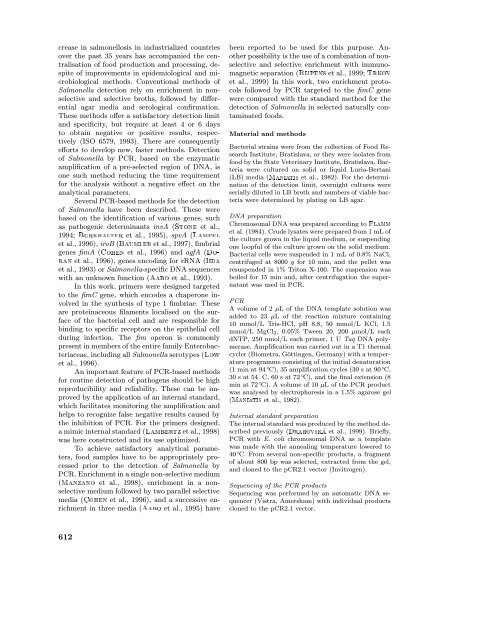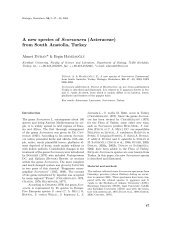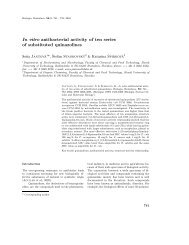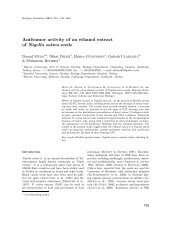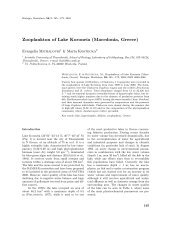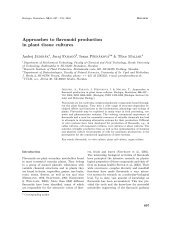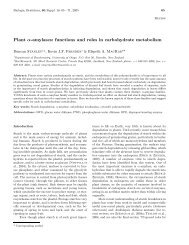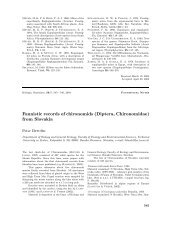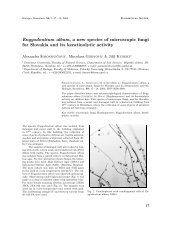Detection of Salmonella by polymerase chain reaction - Biologia ...
Detection of Salmonella by polymerase chain reaction - Biologia ...
Detection of Salmonella by polymerase chain reaction - Biologia ...
You also want an ePaper? Increase the reach of your titles
YUMPU automatically turns print PDFs into web optimized ePapers that Google loves.
crease in salmonellosis in industrialized countries<br />
over the past 35 years has accompanied the centralisation<br />
<strong>of</strong> food production and processing, despite<br />
<strong>of</strong> improvements in epidemiological and microbiological<br />
methods. Conventional methods <strong>of</strong><br />
<strong>Salmonella</strong> detection rely on enrichment in nonselective<br />
and selective broths, followed <strong>by</strong> differential<br />
agar media and serological confirmation.<br />
These methods <strong>of</strong>fer a satisfactory detection limit<br />
and specificity, but require at least 4 or 6 days<br />
to obtain negative or positive results, respectively<br />
(ISO 6579, 1993). There are consequently<br />
efforts to develop new, faster methods. <strong>Detection</strong><br />
<strong>of</strong> <strong>Salmonella</strong> <strong>by</strong>PCR,basedontheenzymatic<br />
amplification <strong>of</strong> a pre-selected region <strong>of</strong> DNA, is<br />
one such method reducing the time requirement<br />
for the analysis without a negative effect on the<br />
analytical parameters.<br />
Several PCR-based methods for the detection<br />
<strong>of</strong> <strong>Salmonella</strong> have been described. These were<br />
based on the identification <strong>of</strong> various genes, such<br />
as pathogenic determinants invA (Stone et al.,<br />
1994; Burkhalter et al., 1995), spvA (Lampel<br />
et al., 1996), iroB (Baumler et al., 1997), fimbrial<br />
genes fimA (Cohen et al., 1996) and agfA (Doran<br />
et al., 1996), genes encoding for rRNA (Iida<br />
et al., 1993) or <strong>Salmonella</strong>-specific DNA sequences<br />
with an unknown function (Aabo et al., 1993).<br />
In this work, primers were designed targeted<br />
to the fimC gene, which encodes a chaperone involved<br />
in the synthesis <strong>of</strong> type 1 fimbriae. These<br />
are proteinaceous filaments localised on the surface<br />
<strong>of</strong> the bacterial cell and are responsible for<br />
binding to specific receptors on the epithelial cell<br />
during infection. The fim operon is commonly<br />
present in members <strong>of</strong> the entire family Enterobacteriaceae,<br />
including all <strong>Salmonella</strong> serotypes (Low<br />
et al., 1996).<br />
An important feature <strong>of</strong> PCR-based methods<br />
for routine detection <strong>of</strong> pathogens should be high<br />
reproducibility and reliability. These can be improved<br />
<strong>by</strong> the application <strong>of</strong> an internal standard,<br />
which facilitates monitoring the amplification and<br />
helps to recognize false negative results caused <strong>by</strong><br />
the inhibition <strong>of</strong> PCR. For the primers designed,<br />
a mimic internal standard (Lambertz et al., 1998)<br />
was here constructed and its use optimized.<br />
To achieve satisfactory analytical parameters,<br />
food samples have to be appropriately processed<br />
prior to the detection <strong>of</strong> <strong>Salmonella</strong> <strong>by</strong><br />
PCR. Enrichment in a single non-selective medium<br />
(Manzano et al., 1998), enrichment in a nonselective<br />
medium followed <strong>by</strong> two parallel selective<br />
media (Cohen et al., 1996), and a successive enrichment<br />
in three media (Aabo et al., 1995) have<br />
612<br />
been reported to be used for this purpose. Another<br />
possibility is the use <strong>of</strong> a combination <strong>of</strong> nonselective<br />
and selective enrichment with immunomagnetic<br />
separation (Rijpens et al., 1999; Trkov<br />
et al., 1999) In this work, two enrichment protocols<br />
followed <strong>by</strong> PCR targeted to the fimC gene<br />
were compared with the standard method for the<br />
detection <strong>of</strong> <strong>Salmonella</strong> in selected naturally contaminated<br />
foods.<br />
Material and methods<br />
Bacterial strains were from the collection <strong>of</strong> Food Research<br />
Institute, Bratislava, or they were isolates from<br />
food <strong>by</strong> the State Veterinary Institute, Bratislava. Bacteria<br />
were cultured on solid or liquid Luria-Bertani<br />
(LB) media (Maniatis et al., 1982). For the determination<br />
<strong>of</strong> the detection limit, overnight cultures were<br />
serially diluted in LB broth and numbers <strong>of</strong> viable bacteria<br />
were determined <strong>by</strong> plating on LB agar.<br />
DNA preparation<br />
Chromosomal DNA was prepared according to Flamm<br />
et al. (1984). Crude lysates were prepared from 1 mL <strong>of</strong><br />
the culture grown in the liquid medium, or suspending<br />
one loopful <strong>of</strong> the culture grown on the solid medium.<br />
Bacterial cells were suspended in 1 mL <strong>of</strong> 0.8% NaCl,<br />
centrifuged at 8000 g for 10 min, and the pellet was<br />
resuspended in 1% Triton X-100. The suspension was<br />
boiled for 15 min and, after centrifugation the supernatant<br />
was used in PCR.<br />
PCR<br />
Avolume<strong>of</strong>2µL <strong>of</strong> the DNA template solution was<br />
added to 23 µL <strong>of</strong> the <strong>reaction</strong> mixture containing<br />
10 mmol/L Tris-HCl, pH 8.8, 50 mmol/L KCl, 1.5<br />
mmol/L MgCl2, 0.05% Tween 20, 200 µmol/L each<br />
dNTP, 250 nmol/L each primer, 1 U Taq DNA <strong>polymerase</strong>.<br />
Amplification was carried out in a T1 thermal<br />
cycler (Biometra, Göttingen, Germany) with a temperature<br />
programme consisting <strong>of</strong> the initial denaturation<br />
(1 min at 94 ◦ C), 35 amplification cycles (30 s at 90 ◦ C,<br />
30 s at 54 C, 60 s at 72 ◦ C), and the final extension (8<br />
min at 72 ◦ C). A volume <strong>of</strong> 10 µL <strong>of</strong> the PCR product<br />
was analysed <strong>by</strong> electrophoresis in a 1.5% agarose gel<br />
(Maniatis et al., 1982).<br />
Internal standard preparation<br />
The internal standard was produced <strong>by</strong> the method described<br />
previously (Drahovská et al., 1999). Briefly,<br />
PCR with E. coli chromosomal DNA as a template<br />
was made with the annealing temperature lowered to<br />
40 ◦ C. From several non-specific products, a fragment<br />
<strong>of</strong> about 800 bp was selected, extracted from the gel,<br />
and cloned to the pCR2.1 vector (Invitrogen).<br />
Sequencing <strong>of</strong> the PCR products<br />
Sequencing was performed <strong>by</strong> an automatic DNA sequencer<br />
(Vistra, Amersham) with individual products<br />
cloned to the pCR2.1 vector.


